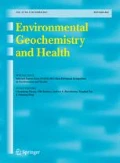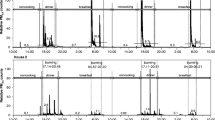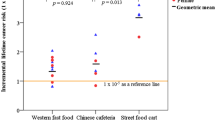Abstract
Polycyclic aromatic hydrocarbons (PAHs) are well-known hazardous substances; nevertheless, research on their exposure and health concerns associated with kerosene fuel emissions is limited. In this study, PAH (combined gaseous and particle phase) monitoring was carried out in the kitchen and living room in selected households. Personal exposure and cooking time monitoring were also carried out, simultaneously. The study's findings revealed that BaP, BA, BbF, and Nap were the most prevalent PAHs in both the summer and winter seasons, regardless of urban or rural households. The estimated values of average incremental lifetime cancer risks were found to be greater than the USEPA level, i.e., 1 × 10–6, in both urban and rural households, regardless of seasonal fluctuation. In both seasons, the non-carcinogenic risk for developmental and reproductive effects was higher in rural women than in urban women, and in case of developmental risk it showed greater than unity (rural: 1.11 and urban 1.03) in the winter season. On the other hand, Monte Carlo simulation model revealed that concentrations of PAHs (97.1% and 97.5%) and exposure duration (51.7% and 56.7%) were the most sensitive factors contributed for health risk estimations for urban and rural area in both seasons, respectively. Furthermore, the results clearly showed that women who were using kerosene for cooking were at a greater risk of acquiring both carcinogenic and non-carcinogenic health consequences from PAH exposure from kerosene cookstoves. It was recommended that they should utilize clean fuel, either by using LPG under the PMUY scheme or by using electricity/solar power to reduce health risks for better health.




Similar content being viewed by others
Availability of data and material
The authors confirm that the data and materials supporting the findings of this study are available within the article.
Code availability
Not applicable.
References
Adetona, O., Li, Z., Sjödin, A., Romanoff, L. C., et al. (2013). Biomonitoring of polycyclic aromatichydrocarbon exposure in pregnant women in Trujillo, Peru—Comparison of different fuel types used for cooking. Environment International, 53, 1–8.
Akhtar, S., Gulali, R. R., & Al-Anezi, F. (2006). Risk factors in acute poisoning in children: A retrospective study. Kuwait Medical Journal, 38, 33–36.
Alexander, D., Northcross, A., Wilson, N., et al. (2017). Randomized controlled ethanol cookstove intervention and blood pressure in pregnant Nigerian women. American Journal of Respiratory and Critical Care Medicine, 195, 1629–1639.
Alexandrov, K., Cascorbi, I., Rojas, M., Bouvier, G., Kriek, E., & Bartsch, H. (2002). CYP1A1 and GSTM1 genotypes affect benzo(a)pyrene DNA adducts in smokers’ lung: Comparison with aromatic/hydrophobic adduct formation. Carcinogenesis, 23, 1969–1977.
Al-Harbi, M., Alhajri, I., & Whalen, J. K. (2020). Health risks associated with the polycyclic aromatic hydrocarbons in indoor dust collected from houses in Kuwait. Environmental Pollution. https://doi.org/10.1016/j.envpol.2020.115054
Anwar, S., Akmin, R., Houqe, S. A., et al. (2014). Clinical profile of kerosene poisoning in a tertiary level hospital in Bangladesh. Bangladesh Journal of Child Health, 38, 11–14.
Arku, R. E., Brauer, M., Duong, M., et al. (2020). Adverse health impacts of cooking with kerosene: A multi country analysis within the prospective Urban and rural epidemiology study. medRxiv preprint: https://doi.org/10.1101/2020.06.19.20135871.
Balakrishnan, K., Sambandam, S., Ramaswamy, P., et al. (2015). Establishing integrated rural–urban cohorts to assess air pollution-related health effects in pregnant women, children and adults in Southern India: An overview of objectives, design and methods in the Tamil Nadu Air Pollution and Health Effects (TAPHE) study. British Medical Journal Open, 5, e008090. https://doi.org/10.1136/bmjopen-2015-008090
Bhargava, A., Khanna, R. N., Bhargava, S. K., & Kumar, S. (2004). Exposure risk to carcinogenic PAHs in indoor air during biomass combustion whilst cooking in rural India. Atmospheric Environment, 38(28), 4761–4767.
Bolden, A. L., Rochester, J. R., Schultz, K., & Kwiatkowski, C. F. (2017). Polycyclic aromatic hydrocarbons and female reproductive health: A scoping review. Reproductive Toxicology, 73, 61–74.
Chakraborty, D., & Mondal, N. K. (2017). Assessment of health risk of children from traditional biomass burning in rural households. Exposure and Health. https://doi.org/10.1007/s12403-017-02421
Chakraborty, D., & Mondal, N. K. (2018). Hypertensive and toxicological health risk among women exposed to biomass smoke: A rural Indian scenario. Ecotoxicology and Environmental Safety, 161, 706–714.
Chakraborty, D., & Mondal, N. K. (2021a). Reduction in household air pollution and associated health risk: A pilot study with an improved cookstove in rural households. Clean Technology and Environmental Policy. https://doi.org/10.1007/s10098-021-02098-9
Chakraborty, D., & Mondal, N. K. (2021b). Estimation of nitrogen dioxide (NO2) due to burning of household biomass fuel and assessment of health risk among women in rural West Bengal. Current World Environment, 16(SI1), 1–8.
Chakraborty, D., Mondal, N. K., & Datta, J. K. (2014). Indoor pollution from solid biomass fuel and rural health damage: A micro-environmental study in rural area of Burdwan, West Bengal. International Journal of Sustainable Built Environment, 3(2), 262–271.
Chen, B., Hu, Y., Jin, T., Zheng, L., et al. (2007). Higher urinary 1-hydroxypyrene concentration is associated with cooking practice in a Chinese population. Toxicology Letters, 171(3), 119–125.
Chen, S. C., & Liao, C. M. (2006). Health risk assessment on human exposed to environmental polycyclic aromatic hydrocarbons pollution sources. Science of the Total Environment, 366, 112–123.
Downward, G. S., Hu, W., Rothman, N., Reiss, B., Wu, G., Wei, F., et al. (2014). Polycyclic aromatic hydrocarbon exposure in household air pollution from solid fuel combustion among the female population of Xuanwei and Fuyuan counties, China. Environmental Science and Technology, 48(24), 14632–14641.
Gaspari, L., Chang, S. S., Santella, R. M., Garte, S., Pedotti, P., & Taioli, E. (2003). Polycyclic aromatic hydrocarbon-DNA adducts in human sperm as a marker of DNA damage and infertility. Mutation Research, 535, 155–160.
Hu, Y., Bai, Z., Zhang, L., Wang, X., Zhang, L., Yu, Q., & Zhu, T. (2007). Health risk assessment for traffic policemen exposed to polycyclic aromatic hydrocarbons (PAHs) in Tianjin, China. Science of the Total Environment, 382, 240–250.
Hussar, E., Richards, S., Lin, Z. Q., Dixon, R. P., & Johnson, K. A. (2012). Human health risk assessment of 16 priority polycyclic aromatic hydrocarbons in soils of Chattanooga, Tennessee, USA. Water, Air, and Soil Pollution, 223(9), 5535–5548.
IARC. (2010). Household use of solid fuels and high-temperature frying. IARC Monographs on the Evaluation of Carcinogenic Risks to Humans, vol. 95. International Agency for Research on Cancer.
Jeong, C. H., Salehi, S., Wu, J., North, M. L., Kim, J. S., Chow, C. W., & Evans, G. J. (2019). Indoor measurements of air pollutants in residential houses in urban and suburban areas: Indoor versus ambient concentrations. Science of the Total Environment, 693, 13446–13457.
Kaupp, H., & McLachlan, M. S. (2000). Distribution of polychlorinated dibenzo-P-dioxins and dibenzofurans (PCDD/Fs) and polycyclic aromatic hydrocarbons (PAHs) within the full size range of atmospheric particles. Atmospheric Environment, 34, 73–83.
Khaiwal, R., Ranjeet, S., & RenéVan, G. (2008). Atmospheric polycyclic aromatic hydrocarbons: Source attribution, emission factors and regulation. Atmospheric Environment, 42(13), 2895–2921.
Lam, N. L., Smith, K. R., et al. (2012). Kerosene: A review of household uses and their hazards in low- and middle income countries. Journal of Toxicology and Environmental Health, Part B: Critical Reviews, 15(6), 396–432.
Lisouza, F. A., Owuor, O. P., & Lalah, J. O. (2011). Variation in indoor levels of polycyclic aromatic hydrocarbons from burning various biomass types in the traditional grassroofed households in Western Kenya. Environmental Pollution, 159(7), 1810–1815.
Liu, S., et al. (2008). Seasonal and spatial occurrence and distribution of atmospheric polycyclic aromatic hydrocarbons (PAHs) in rural and urban areas of the North Chinese Plain. Environmental Pollution, 156, 651–656.
Liu, W., Zhang, J., Hashim, J. H., Jalaludin, J., Hashim, Z., & Goldstein, B. D. (2003). Mosquito coil emissions and health implications. Environmental Health Perspectives, 111, 1454–1460.
Majumdar, D., Dutta, C., & Sen, S. (2016). Inhalation exposure or body burden? Better way of estimating risk—An application of PBPK model. Environmental Toxicology and Pharmacology, 41, 54–61.
Majumdar, D., Mukherjee, A. K., Mukhopadhaya, K., & Sen, S. (2012). Variability of BTEX in residential indoor air of Kolkata Metropolitan City. Indoor and Built Environment, 21(3), 374–380.
Mitra, P., Chakraborty, D., & Mondal, N. K. (2022). Assessment of household air pollution exposure of tribal women. Science of the Total Environment. https://doi.org/10.1016/j.scitotenv.2021.152869
National Sample Survey Office. NSS Rep 68th round (July 2011- June 2012). [cited 2015 November 14]. http://mospi.nic.in/Mospi_New/upload/nss_report_567.pdf
Nisbet, I. C. T., & LaGoy, P. K. (1992). Toxic equivalency factors (TEFs) for polycyclic aromatic hydrocarbons (PAHs). Regulatory Toxicology and Pharmacology, 16, 290–300.
Offenberg, J. H., & Baker, J. E. (2000). Aerosol size distributions of elemental and organic carbon in urban and over-water atmospheres. Atmospheric Environment, 34, 1509–1517.
Peterson, B. S., Rauhm, V. A., Bansal, R., Hao, X., Toth, Z., Nati, G., Walsh, K., Miller, R. L., Arias, F., Semanek, D., & Perera, F. (2015). Effects of prenatal exposure to air pollutants (polycyclic aromatic hydrocarbons) on the development of brain white matter, cognition, and behavior in later childhood. JAMA Psychiatry, 72(6), 531–540.
Pufulete, M., Battershill, J., Boobis, A., & Fielder, R. (2004). Approaches to carcinogenic risk assessment for polycyclic aromatic hydrocarbons: A UK perspective. Regulatory Toxicology and Pharmacology, 40, 54–66.
Sharma, D., & Jain, S. (2020). Carcinogenic risk from exposure to PM2.5 bound polycyclic aromatic hydrocarbons in rural settings. Ecotoxicology and Environmental Safety, 190, 110135.
Shi, J., et al. (2010). Characterization and source identification of PM10-bound polycyclic aromatic hydrocarbons in urban air of Tianjin, China. Aerosol Air Quality and Research, 10, 507–518.
Shih R. H. (1998). In: Goldfrank, L. R., (Ed.), Flomenbaum NE, with 86 Editors. Goldfrank's Toxicologic Emergencies, 6th edn. Appleton & Lange.
Tiwari, M., Sahu, S. K., & Pandit, G. G. (2015). Inhalation risk assessment of PAH exposure due to combustion aerosols generated from household fuels. Aerosol and Air Quality Research, 15, 582–590.
USEPA (US Environmental Protection Agency). (1991). Risk assessment guidance for superfund, volume I: Human health valuation manual, supple mental guidance: “Standard fault exposure factors”. OSWER Directive: 9285.6–03, Washington DC
USEPA (US Environmental Protection Agency). (1997). Exposure factors handbook, update to exposure factors handbook, EPA/600/8-89/043-May 1989. EPA/600/P-95/002Fa.
USEPA. (1989). Risk assessment guidance for superfund. Human health evaluation manual, (part A), vol. 1.EPA/540/1-89/002. Office of emergency and remedial response, Washington, DC. http://www.epa.gov/oswer/riskassessment/ragsa/pdf/rags_a.pdf
USEPA. (1993). Provisional guidance for quantitative risk assessment of polycyclic aromatic hydrocarbons, EPA/600/R-93/089
USEPA. (2017). Integrated risk information system (IRIS) database. www.epa.gov/iris. Accessed date: 20 July 2018
Vu, V. T., Lee, B. K., Kim, J. T., Lee, C. H., & Kim, I. H. (2011). Assessment of carcinogenic risk due to inhalation of polycyclic aromatic hydrocarbons in PM10 from an industrial city: A Korean case-study. Journal of Hazards Materials, 189, 349–356.
WHO. (1998). Environmental Health Criteria 202: Selected Non-heterocyclic Polycyclic Aromatic Hydrocarbons. (International Programme on Chemical Safety).
Yang, T. T., Hsu, C. Y., Chen, Y. C., Young, L. H., Huang, C. H., & Ku, C. H. (2017). Characteristics, sources, and health risks of atmospheric PM2.5-bound polycyclic aromatic hydrocarbons in Hsinchu, Taiwan. Aerosol and Air Quality Research, 17, 563–573.
Yanxu, Z., & Shu, T. (2009). Global atmospheric emission inventory of polycyclic aromatic hydrocarbons (PAHs) for 2004. Atmospheric Environment, 43(4), 812–819.
Ye, W., Saikawa, E., Avramov, A., Cho, S. H., & Chartier, R. (2020). Household air pollution and personal exposure from burning firewood and yak dung in summer in the eastern Tibetan Plateau. Environmental Pollution, 263, 114531.
Zhang, Y., & Tao, S. (2009). Global atmospheric emission inventory of polycyclic aromatic hydrocarbons (PAHs) for 2004. Atmospheric Environment, 43, 812–819.
Zheng, Y., et al. (2014). Assessing the polycyclic aromatic hydrocarbon (PAH) pollution of urban stormwater runoff: A dynamic modeling approach. Science of the Total Environment, 481, 554–563.
Acknowledgements
The authors are thankful to the Indian Council of Medical Research (ICMR), Govt. of India and all the faculties and non-teaching staff of the Department of Environmental Health Engineering, Faculty of Public Health, Sri Ramachandra Institute of Higher Education and Research (DU), Chennai, India, for their unconditional help and moral support and providing necessary infrastructure for conducting the research.
Funding
The authors acknowledge the funding of this study by the Indian Council of Medical Research (ICMR) (Research Project No.: 5/8/4–20(ENV)/2015-NCD-I), Govt. of India.
Author information
Authors and Affiliations
Contributions
KM was involved in conceptualization and methodology, supervised the investigation, writing—review and editing of the manuscript; Deep Chakraborty wrote the manuscript, executed all the data analysis and modeling, field investigation, laboratory analysis, visualization, review and editing; SN performed field investigation and laboratory analysis; SS and KB did investigation and review
Corresponding author
Ethics declarations
Conflict of interest
Authors declared no conflict of interest.
Additional information
Publisher's Note
Springer Nature remains neutral with regard to jurisdictional claims in published maps and institutional affiliations.
Rights and permissions
About this article
Cite this article
Mukhopadhyay, K., Chakraborty, D., Natarajan, S. et al. Monitoring of polycyclic aromatic hydrocarbons emitted from kerosene fuel burning and assessment of health risks among women in selected rural and urban households of South India. Environ Geochem Health 45, 1445–1459 (2023). https://doi.org/10.1007/s10653-022-01276-y
Received:
Accepted:
Published:
Issue Date:
DOI: https://doi.org/10.1007/s10653-022-01276-y




